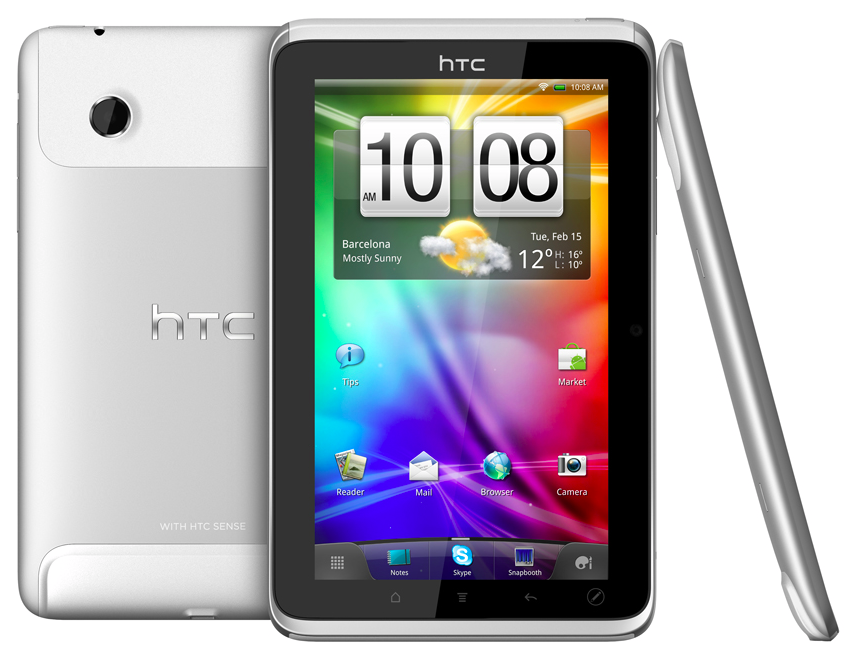HTC Unveils the Flyer. It Can Play Crysis.
...thanks to OnLive.

HTC makes a good number of Android phones, so it only makes sense that the company would also be taking part in the Android tablet market. As expected, HTC announced the Flyer tablet, which runs an all-new HTC Sense – not on Honeycomb like many of the other Android tablets – but rather on Gingerbread (2.3 or 2.4).
Another big difference between the Flyer and the rest is that it uses stylus/pen interaction on top of natural touch. HTC also announced HTC Watch, a new connected video service that will debut on HTC Flyer tablet, and will collaborate with OnLive, Inc. to launch the first cloud-based mobile gaming service on a tablet. Does that mean that the Flyer can play Crysis? Yes, it can.
"Clearly, smartphones have transformed our lives but as we observed how people use smartphones, computers and other technologies, we saw an opportunity to create a tablet experience that is different, more personal and productive," said Peter Chou, CEO of HTC Corporation. "We are progressing down a path as an industry when people will no longer be in a single device paradigm, but have multiple wireless devices for different needs; this is the direction we are moving."
In terms of physical traits, the HTC Flyer is encased in an aluminum unibody with a seven-inch display, 1.5GHz single core processor and high-speed HSPA+ wireless capabilities. HTC says that it chose a speedy single core over slower dual cores because Android currently doesn't support multithreading outside of the browser.
While stylus interaction has fallen to the wayside due to capacitive touch, HTC is hoping to bring it back with what it calls Scribe Technology. Such features include Timemark, which enables you to capture the audio of a meeting in line with your written notes, so tapping on a word in your notes instantly takes you to that exact place in time in the audio recording of the meeting. Notes are also integrated with the calendar so when there is an appointment reminder you are automatically prompted with an opportunity to begin a new note or in the case of recurring meetings, to continue where the last meeting left off. Evernote users will be pleased to learn that that it is all integrated into HTC's software.
HTC Flyer will be available to customers globally during Q2 2011.
HTC Flyer Specifications
Processor
1.5GHz
Platform
Bluetooth® 3.0 with A2DP for wireless stereo headsets Wi-Fi®: IEEE 802.11 b/g/n 3.5 mm stereo audio jack Micro-USB (12-pin micro-USB 2.0)
5 megapixel colour camera with auto focus
1.3 megapixel front camera
Memory
AndroidTM with HTC SenseTM
Internal storage: 32 GB RAM: 1 GB Micro SD memory card extension (SD 2.0 compatible) The actual available internal storage may differ depending on the software configuration of your device
Camera
Dimensions (LxWxT)
Audio supported formats
Playback: .aac, .amr, .ogg, .m4a, .mid, .mp3, .wav, .wma (Windows Media Audio 9) Recording: .amr, .aac
Video supported formats
Weight Display
195.4 x 122 x 13.2 mm Around 415 grams with battery
7 inch touch-sensitive TFT screen with 1024 X 600
resolution
Playback: .3gp, .3g2, .mp4, .wmv (Windows Media Video 9), .avi (MP4 ASP and MP3), .xvid (MP4 ASP and MP3) Recording: .3gp
Rechargeable battery Capacity: 4000 mAh Standby time: Up to 820 ~1470 hours Video Playback: Up to 4 hours All subject to network and device usage
Network
GPS Sensors
HSPA/WCDMA: 900/AWS/2100 MHz Upload speed of up to 5.76 Mbps and download speed of up to 14.4 Mbps Quad-band GSM/GPRS/EDGE: 850/900/1800/1900 MHz Band frequency, HSPA availability, and data speed are operator dependent
Internal GPS antenna
Ambient light sensor G-Sensor Digital compass
AC adapter
Voltage range/frequency: 100 ~ 240V AC, 50/60 Hz DC output: 9V and 1.67A
Please note: Specifications are subject to change without prior notice
Sign up to get the BEST of Tom's Guide direct to your inbox.
Get instant access to breaking news, the hottest reviews, great deals and helpful tips.
Marcus Yam is a technology evangelist for Intel Corporation, the latest in a long line of tech-focused roles spanning a more than 20-year career in the industry. As Executive Editor, News on Tom's Guide and Tom's Hardware, Marcus was responsible for shaping the sites' news output, and he also spent a period as Editor of Outdoors & Sports at Digital Trends.
-
Computerrock1 Sweetness, the idea of parallel gaming (cloud-gaming), using a mobile device to control a desktop to play a game has come to actuality!!Reply -
itchyisvegeta If they can account for the latency issues for cloud gaming on a portable device, then this will be the best thing since the George Forman grill.Reply -
HTC sure has come a long way from their bug-ridden Touch Diamond's - I am quite impressed. One one hand - Superb design. Great processor. Promising battery life (hopefully around the 10 hr mark). On the other hand - Honeycomb would have made more sense given that it is a tablet, and to really knock the ball out of the park HTC would have needed nvidia tegra graphics. OnLive is a nice touch, but more gimmicky than practical - unless you're tethered to an ethernet port you're not going to get the bandwidth to really make use of it.Reply
-
someguynamedmatt It's just not the same as having the power to completely render it yourself. This is more related to desktop gaming PCs, but it's just so much better having all that rendering power humming beside you while you play than having someone else do the work for you and then stream it to your computer.Reply -
c0oim4n But can it play Cry-Reply
Oh wait... =P
But seriously? You probably wouldn't even manage 5 FPS on that thing, if you actually DID decide to play Crysis on it? Kinda pointless to have OnLive on this sort of device anyways, with the slower speeds of the network...
